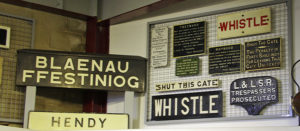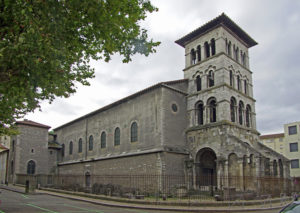The Talyllyn Railway Preservation Society were a far sighted group. As well as preserving the Talyllyn Railway, they were also concerned about the disappearance of other narrow gauge railways around Britain. They suggested that they form a museum to preserve some of the locos, wagons and other artefacts of this rapidly disappearing part of our heritage. Many items were donated and they soon had an excellent collection of locos, wagons signalling equipment, signs and tickets. The information boards look at the historical development of narrow gauge railways from early plateways, their use in industry especially the Welsh slate quarries and also in the First World War.
There is also a reconstruction of Rev Awdry’s study. He was an early volunteer on the Talyllyn Railway on which he based the stories of Skarloey’s railway. His engines were based on Talyllyn locos and many of the stories are based on actual events. Peter Sam’s Giesl injector is on display. For those who don’t know the story, it can be seen here.
In 1958 Edward Thomas was chosen to test a Giesl ejector blastpipe and fishtail chimney designed by the Austrian inventor Dr Giesl-Gieslingen. It was a very distinctive funnel and generated a lot of publicity but had little effect on performance. It was eventually replaced in 1969 and placed in the museum.
Narrow gauge railways were cheaper to build than standard gauge and were popular where space was limited. They were extensively used on industrial sites including brickworks, breweries, engineering works, waterworks, gas,coal and steel plants. They were very important during the First World War to move men and supplies. Petrol or paraffin engines were preferred as their exhaust was less visible. Woolwich Arsenal continued to use narrow gauge railways until 1973 and the RAF until the 1980s.
The first tramways appeared in the C18th and were worked either with horses or fixed winches using ropes or chains. Early wagons were simple flat bed trucks propelled by hand along the level tramways. Examples of flat bed trucks include one from Bryneglwys Quarry to carry slabs of slate from the quarry face to the splitting floor. There is a truck from the Forest of Dean used to carry limestone and a flat wagon or trolly was used by the Royal Arsenal in Woolwich from 1911 until 1973.
Early wagons were made of wood which was later replaced by steel. There are examples of early wooden wagons from the Oakeley Slate Quarries at Blaenau Ffestiniog and a steel wagons from the horse worked Nantlle Tramway.
The gauge of narrow gauge railways varied and this lead to problems if wagons had to be transferred between different gauge railways. The gauge of the mighty Dinorwic Quarry railway carrying slate to the sea was 4’. That of the feeder railways bringing slate from the quarries was less than 2’. This problem was solved by ‘host wagons’. Up to four slate wagons could be loaded onto flat beds. Quarry men could also travel in these as well as slate. The first and last flatbeds of a train carried a tall ‘sentry box’ break van.
In very mountainous areas, cable worked inclines were built and many can still be seen on the hills around places like Blaenau Ffestiniog. At Criag Ddu quarry, the men would be hauled up the incline in the morning in empty slate wagons. In the evening after the slate wagons ceased to run, they travelled back down the incline by Car Gwyllt (wild car). This was a small seat which was suspended between the middle pair of rails on double track inclines. The cars were then placed in the empty slate wagons ready to be hauled up next morning. It took eight minutes to cover a journey of 1800 yards with a descent of 1040’, and this included time taken to walk between the three inclines. Scary!
The Ffestiniog Railway pioneered the use of steam locos in 1863 and other railways were quick to follow. Steam was gradually replaced by diesel in the early 1930s. The museum has an interesting selection of narrow gauge steam engines, including George Henry, an 1877 vertical boiler steam engine made by de Winton of Caernarfon, which ran on the Penrhyn Quarry Railway. The diminutive Dot, built in 1887 by the Beyer Garrett Company, spent its working life shunting and moving material on 18” track around their works at Gorton. The cabless Rough Pup was built by the Hunslet Engine Company in 1891 for the Dinorwic Quarries. It was taken to Llanberis by rail and then dismantled before being hauled up the inclines. It was then reassembled before hauling slate and waste on the levels high above the valley. Locomotive 13 was built by William Spence and company in Dublin in 1895 and worked in the Guinness Brewery in Dublin.
The star of the loco collection is Jubilee built in 1897 by Manning Wardle and Company in Leeds for Cilgwyn Quarry near Nantlle. When the quarry closed it was sold to the Penrhyn Quarry Company. It was one of the largest locos ever built to work on the narrow gauge quarry lines. This is a very popular exhibit as visitors are allowed onto the footplate.
The museum walls are covered with engine nameplates and railway signs. There are signal levers, token machines and telephones as well as bells and repeaters.
Many narrow gauge have now disappeared, having been replaced by all lorries, trucks, conveyor belts and fork lift trucks in the 1950s. The Talyllyn was the first railway to be preserved by a group of volunteers, soon followed by the Ffestiniog Railway. Others followed. The museum is a wonderful memory of the glory days of the narrow gauge railways. It is well worth allowing time to visit it after a trip on the Talyllyn Railway.









